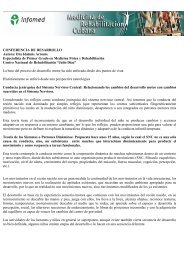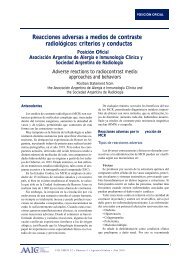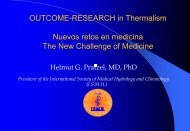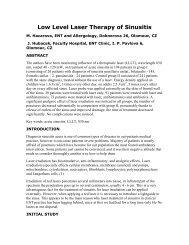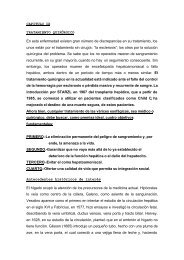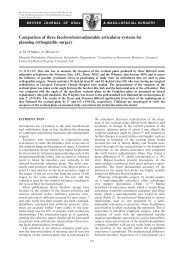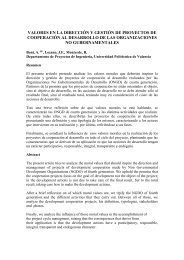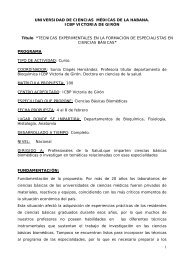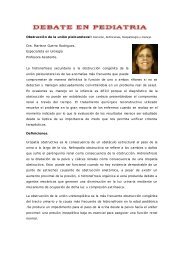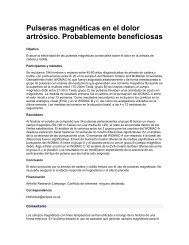pharmacology of medicinal plants and natural products
pharmacology of medicinal plants and natural products
pharmacology of medicinal plants and natural products
Create successful ePaper yourself
Turn your PDF publications into a flip-book with our unique Google optimized e-Paper software.
MEDICINAL PLANTS (NATURAL PRDUCTS)<br />
S83<br />
Administration <strong>of</strong> BR-16A for 7 days induced dose<br />
related anxiolytic effects as assessed by paradigms<br />
like the open field <strong>and</strong> elevated plus maze tests in<br />
mice <strong>and</strong> the social interaction <strong>and</strong> Vogel’s drink conflict<br />
tests in rats. It attenuated the increase in rat brain<br />
tribulin levels, a putative endocoid anxiety marker<br />
footshock - induced aggressive behaviour in paired<br />
rats but failed to affect clonidine-induced automutilative<br />
behaviour. Reduction in swim stress induced<br />
immobility in Porsolt’s behavioural despair test,<br />
reduction in escape failures concomitant with an increase<br />
in avoidance response in the learned helplessness<br />
test <strong>and</strong> attenuation <strong>of</strong> muricidal behaviour<br />
in rats demonstrated that it possesses anti-depressant<br />
properties 21 .<br />
2.3. Agents attenuating dependence<br />
Chronic treatment with the root extract <strong>of</strong> Withania<br />
somnifera (Ashwag<strong>and</strong>ha) attenuated the development<br />
<strong>of</strong> tolerance <strong>and</strong> also the development <strong>of</strong> dependence<br />
to morphine in mice. By itself, Withania<br />
somnifera showed no analgesic effect 22 .<br />
2.4. Anticonvulsants<br />
In a study carried out by Manocha, et al 23 , Ginkgo<br />
biloba decreased the protective effect <strong>of</strong> sodium valproate<br />
<strong>and</strong> carbamazepine against picrotoxin as well<br />
as strychnine induced convulsions in mice. Further<br />
studies showed that pre-treatment with Ginkgo biloba<br />
extract potentiated the convulsions produced by<br />
picrotoxin <strong>and</strong> strychnine, indicating the involvement<br />
<strong>of</strong> GABAergic system <strong>and</strong> chloride channels (for<br />
picrotoxin) <strong>and</strong> modulation <strong>of</strong> action <strong>of</strong> the glycine<br />
neurotransmitter (for strychnine) by Ginkgo biloba 24 .<br />
Panax ginseng was shown to have no anticonvulsant<br />
action, nor did it potentiate the anticonvulsant<br />
effects <strong>of</strong> phenobarbitone <strong>and</strong> diazepam 18 .<br />
Chronic administration <strong>of</strong> BR-16A was found to protect<br />
against pentylenetetrazole (PTZ) induced kindling<br />
in mice, demonstrating the role <strong>of</strong> GABA<br />
receptor in PTZ induced kindling <strong>and</strong> protection by<br />
BR-16A by its interaction with these receptors 25 .<br />
Caffeine intake has been shown to increase the<br />
plasma half- life (2-fold) <strong>and</strong> reduce the bioavailability<br />
by 32% <strong>of</strong> carbamazepine in normal human volunteers.<br />
No interaction was seen with sodium valproate.<br />
These results indicate the need for restriction<br />
<strong>of</strong> xanthine/caffeine consumption in patients on<br />
carbamazepine therapy 26 .<br />
2.5. Sedatives<br />
The non-polar fractions <strong>of</strong> the leaf <strong>of</strong> Vernonia species<br />
(Sahadevi) viz. Vernonia lasiopus <strong>and</strong> Vernonia<br />
galamensis have been shown to have sedative properties<br />
in rats 27 .<br />
2.6. Analgesics<br />
Gossypin , a bi<strong>of</strong>lavonoid from the yellow petals <strong>of</strong><br />
Hibiscus vitifolius (Bhasadwaji), has been shown to<br />
have anti-nociceptive activity, similar to morphine <strong>and</strong><br />
involving multineurotransmitter systems, mainly the<br />
cholinergic <strong>and</strong> GABAergic neurotransmitter pathways.<br />
Gossypin pre-treatment significantly decreased<br />
the development <strong>of</strong> acute tolerance to morphine induced<br />
anti-nociception (acetic acid induced writhing<br />
assay). Thus, it is a potential c<strong>and</strong>idate for clinical<br />
trials as an analgesic with the advantages <strong>of</strong> lack <strong>of</strong><br />
tolerance <strong>and</strong> dependence liability 28 .<br />
Suppression <strong>of</strong> acetic acid writhing was seen with<br />
both the ethanol extract <strong>and</strong> cold aqueous infusion<br />
<strong>of</strong> Vitex leucoxylon 16 .<br />
Azadirachta indica showed analgesic properties in<br />
mice. Pre-treatment with the opioid antagonist,<br />
naloxone <strong>and</strong> central noradrenaline depletor,<br />
DSP-4, attenuated the analgesia whereas the serotonin<br />
synthesis inhibitor, PCPA, potentiated the same,<br />
suggesting that both central <strong>and</strong> peripheral mechanisms<br />
<strong>and</strong> complex neural pathways (opioid <strong>and</strong> nonopioid<br />
i.e. monoaminergic) may be involved in this<br />
effect 29 .<br />
Cerpegin, a novel furopyridine alkaloid isolated from<br />
Ceropegia juncea Roxb. (Bhutumbi), has shown an<br />
analgesic effect (not involving the opioid pathway)<br />
against acetic acid induced writhing in mice 30 . Using<br />
the same model in rats, significant analgesic activity<br />
was detected in leaf <strong>and</strong> seed <strong>of</strong> Vernonia lasiopus<br />
<strong>and</strong> Vernonia galamensis 27 <strong>and</strong> alcoholic extract <strong>of</strong><br />
Ochna obtusata (Kanakchampak) stem bark 31 . Panax<br />
ginseng exhibited anti-nociceptive activity <strong>and</strong> potentiated<br />
the anti-nociceptive activity <strong>of</strong> both pentazocine<br />
<strong>and</strong> aspirin 18 .<br />
The PEE, BE <strong>and</strong> EE <strong>of</strong> the roots <strong>of</strong> Pongamia<br />
pinnata showed significant analgesic effect in the tail<br />
flick test 4 . The PEE <strong>and</strong> direct EE <strong>of</strong> the seeds also<br />
showed 3 significant analgesic activity at doses higher<br />
than 100 mg/ kg.




